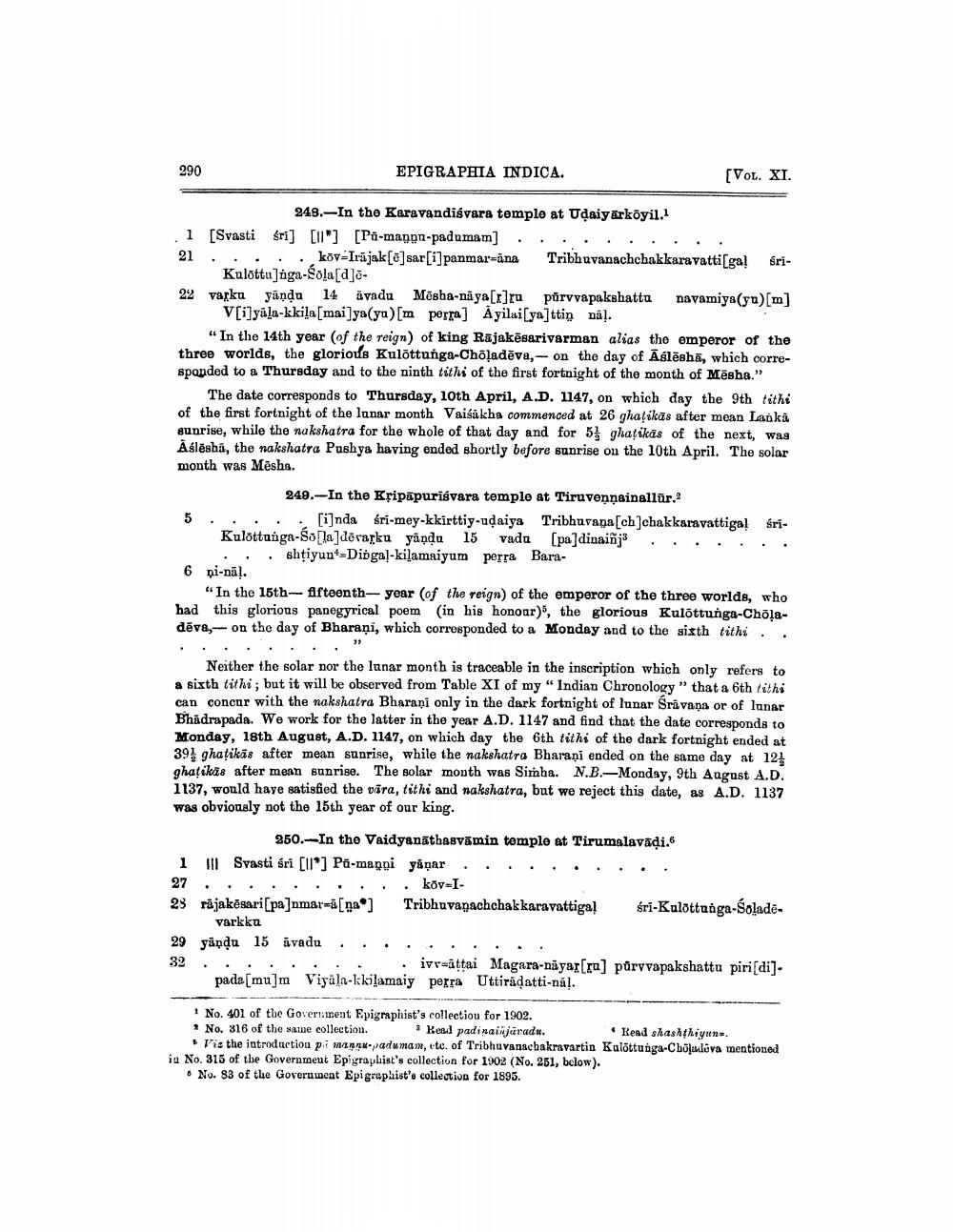________________
290
EPIGRAPHIA INDICA.
[VOL. XI.
248.-In the Karavandisvara temple at Udaiyārköyil. .1 [Svasti sri] [11] [Pü-manga-padumam] ........... 21 .....köv=Irājak[@]sar[i]panmar=ana Tribhuvanachchakkaravatti[ga! sri
Kulottu]óga-Sola[d]e22 vagku yandı 14 ávadu Mēsha-nāya[r]ru pūrvvapakshatta navamiya(yn)[m]
V[i]yala-kkila[mai]ya(ya)[m perra] Ayilaisya]ttin na!. “In the 14th year of the reign) of king Rajakēsarivarman alias the emperor of the three worlds, the glorious Kulõttunga-Choladēva,- on the day of Aslesha, which correspapded to a Thursday and to the ninth tithi of the first fortnight of the month of Mësha."
The date corresponds to Thursday, 10th April, A.D. 1147, on which day the 9th tithi of the first fortnight of the lanar month Vaisakha commenced at 26 ghatikās after mean Lanka sunrise, while the nakshatra for the whole of that day and for 5 gharikas of the next, was Āślēshi, the nakshatra Pushya having ended shortly before sunrise on the 10th April. The solar month was Mēsha.
249.-In the Kripapurisvara templo at Tiruvennainallür. 5 .
[]nda sri-mey-kkirttiy-udaiya Tribhuvana[ch]chakkaravattiga! sriKulottungn-So [la]dorarku yandı 15 vada [pa]dinaiñj .
. . . shtiyun -Divgal-kilamaiyum perra Bara6 pi-nā!.
"In the 15th-Afteenth-year (of the reign) of the emperor of the three worlds, who had this glorious panegyrical poem (in his honoar), the glorious Kulottunga-Chāļadēva,-- on the day of Bharaņi, which corresponded to a Monday and to the sixth tithi. .
Neither the solar nor the lunar month is traceable in the inscription which only refers to a sixth tithi; but it will be observed from Table XI of my " Indian Chronology” that a 6th tithi can concur with the nakshatra Bharani only in the dark fortnight of lunar Sravana or of lanar Bhadrapada. We work for the latter in the year A.D. 1147 and find that the date corresponds to Monday, 18th August, A.D. 1147, on which day the 6th tithi of the dark fortnight ended at 39 ghatikās after mean sunrise, while the nakshatra Bharani ended on the same day at 124 ghafikas after mean sunrise. The solar month was Simha. N.B.-Monday, 9th August A.D. 1137, would haye satisfied the vāra, tithi and nakshatra, but we reject this date, as A.D. 1137 was obviously not the 15th year of our king.
250.-In the Vaidyanathasvāmin temple at Tirumalavadi. 1 !!! Svasti sri [11°] Pa-mappi yaņar . . . . . . . . . . 27 .
kov-I. 23 rājakësari(pa]nmar=ā[na] Tribhuvanachchakkaravattiga! sri-Kulottunga-solade
varkku 29 gàodu 15 avadu . ....... .. 32 . . . . . .
ivr-attai Magara-nayar[ru] púryvapakshattu piri[di]pada[mu]m Vigala-kkilamaiy perra Uttiradatti-nál.
1 No. 401 of the Government Epigraphist's collectiou for 1902. * No. 816 of the same collection. Kead padinainjäradu.
Kead shashthiyans. Vis the introduction pi minnaduma, etc. of Tribhuvanachakravartin Kalõttunga-Chöļudova mentioned ia No. 315 of the Government Epigraplist's collection for 1902 (No. 261, below).
No. 83 of the Government Epigraphist's collection for 1895.




